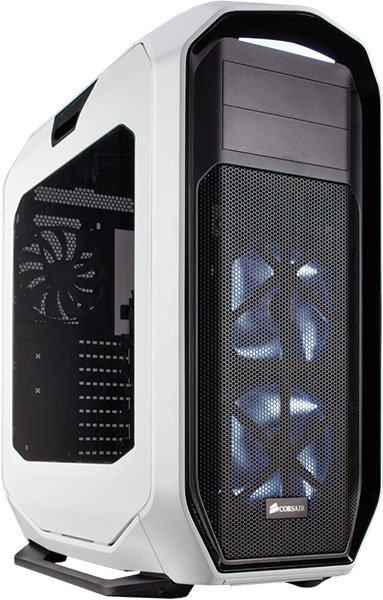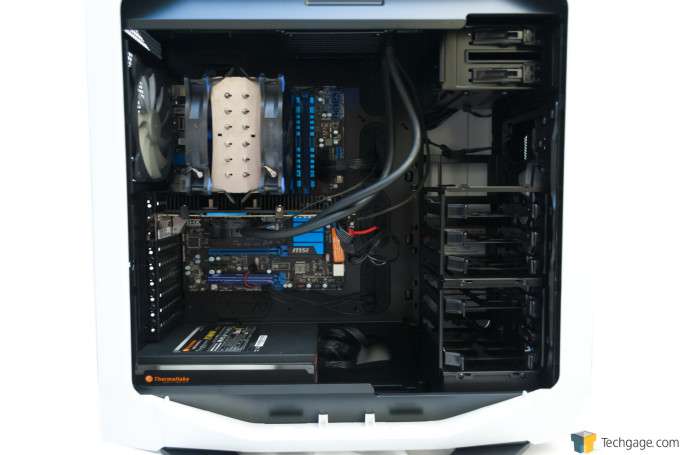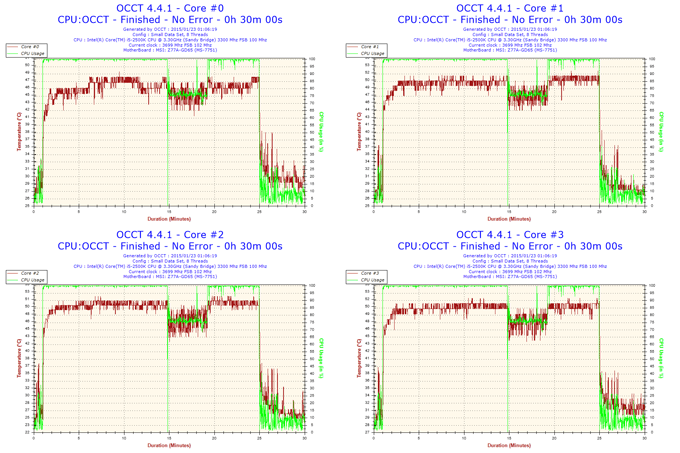- Qualcomm Launches Snapdragon 4 Gen 2 Mobile Platform
- AMD Launches Ryzen PRO 7000 Series Mobile & Desktop Platform
- Intel Launches Sleek Single-Slot Arc Pro A60 Workstation Graphics Card
- NVIDIA Announces Latest Ada Lovelace Additions: GeForce RTX 4060 Ti & RTX 4060
- Maxon Redshift With AMD Radeon GPU Rendering Support Now Available
Synergy of Style and Design: A Review of the Corsair Graphite 780T

All too often, design and style exist in conflict with each other. Form follows function, as the saying goes. But sometimes, we see products which are as beautifully-styled as they are well-designed. Corsair’s Graphite 780T full-tower becomes a perfect example of this – it’s great looking and functional. Let’s check it out.
Page 2 – Performance Testing & Final Thoughts
I’ll be reviewing the Corsair Graphite 780T on a few key criteria: ease of system installation; cooling performance; a subjective evaluation of its noise output characteristics; and a few miscellaneous comments about the chassis’ build quality.
All told, it took around twenty-five minutes or thereabouts to put everything in and secured into the 780T. System installation was a breeze, aided by the immense interior space available as well as the pre-installed standoffs and the Corsair-originated central key standoff.
The design of the drive retention systems, whether we’re talking about the sleds in the drive cages or the SSD-only sleds, also made for a user-friendly installation phase.
Hooking up the various power and data transmission cables, though, was slightly complicated because of a possible oversight by Corsair. The problem lies in that massive bundle of cables leading from the front panel I/O cluster. I wish that Corsair had done a better job of separating the various cables; instead, once you separate the cables to connect them up to their various leads on the system board, they easily become an unsightly mess that, if you’re careless, might lead to tangled cables. One possible remedy would be to sleeve these cables, at least for part of their length. This would go a long way towards tidying up that mass of cables and simplifying cable management.
Here are the specs of the test system:
| Chassis Test System | |
| Processor | Intel Core i5 2500K @ 3.3GHz/1.2V VCore |
| Motherboard | MSI Z77A-GD65 |
| Memory | G.SKILL Ripjaws DDR3 1600 2 x 4GB |
| Graphics | EVGA NVIDIA GeForce GTX 680 (Reference design) |
| Audio | Onboard |
| Storage | Crucial C300 (128GB) SSD |
| Power Supply | Thermaltake 1500W Gold |
| Chassis | Corsair Graphite 780T |
| CPU Cooling | NZXT Havik 140 |
| GPU Cooling | Arctic Accelero Hybrid II-120 |
| OS | Windows 8 64-bit |
Moving on to thermal testing, I will use the OCCT CPU stability test program to generate maximum CPU load and temperatures as well as MSI Kombustor for the GPU temperature testing. Ambient temperature will be kept constant at 72°F/22.2°C.
A preliminary note about thermal testing: A PC chassis being reviewed ought to be in as close to stock configuration as possible. That means I won’t add fans to the system (other than what comes with certain components’ cooling systems). Also, per my now routine practice, I’ll also use the same torture tests to put the CPU and the GPU under maximum load conditions. OCCT is the torture test of choice for the CPU, while MSI Kombustor fits the bill for the GPU.
So this is how the Graphite 780T fared:
The test system registered maximum CPU temperatures of 48°/51°/51°/51°C on each of the four cores of the i5 2500K. This compares quite favorably with other PC chassis I’ve installed the test system in, as the following table shows:
| Chassis | Maximum Core Temperatures Recorded |
| Danger Den Torture Rack | 50°/54°/54°/55° C |
| Corsair Obsidian 450D | 49°/52°/51°/51° C |
| Puget Systems Test Bench | 51°/54°/54°/54° C |
| Corsair Graphite 730T | 48°/52°/52°/52° C |
| Lian Li PC-A61 | 48°/51°/52°/52° C |
| Thermaltake Core V51 | 50°/52°/51°/51° C |
| Corsair Graphite 780T | 48°/51°/51°/51°C |
The Graphite 780T’s thermal dissipation performance joins its Corsair kin and the Lian Li PC-A61 as joint best given the scant differences. If you truly want to split hairs, the 780T does the best on a core-by-core basis, according to the accumulated data.
The data show that Corsair truly has a handle on how to design its chassis’ airflow to promote optimum CPU air cooling. In purely stock configuration, the two blue LED 140mm fans up front and the single 140mm fan in the rear exhaust position do a great job at keeping air moving into and out of the 780T. There’s potential for performance improvement if the user adds more fans to the chassis.
So the 780T performs as well as its best competitors as far as CPU cooling is concerned. But how does it do with GPU cooling?
According to the test data, the 780T matches the best closed-chassis performance tallied so far. The 52°C maximum GPU temperature is also a scant 2°C shy of the best performance that I’ve observed. A look at the table of accumulated data puts the 780T’s excellence in some context:
| Chassis | Maximum GPU Temperatures Recorded |
| Danger Den Torture Rack | 55° C |
| Corsair Obsidian 450D | 63° C |
| Puget Systems Test Bench | 50° C |
| BitFenix Neos | 68° C |
| Corsair Graphite 730T | 57° C |
| Lian Li PC-A61 | 52° C |
| Thermaltake Core V51 | 74° C |
| Corsair Graphite 780T | 52°C |
To be the joint best in GPU cooling is hugely impressive, indeed. It’s clear that, underneath the stylish bodywork lies excellent design principles.
As far as subjective observations on noise suppression go, all I can say is the 780T doesn’t let much sound escape from its innards. The supplied fans are also quiet. Corsair doesn’t appear to have done anything exceptional with the 780T as far as noise suppression is concerned – there’s no sound-dampening foam or anything of the sort lining any of the panels – but it still doesn’t let a lot of sound escape.
In terms of build quality, the Graphite 780T feels as solid as a chassis can. There’s very little shake or rattle in the structure. The paintwork looks smooth. The engineered bits – the thumbscrews, the drive retention systems, even the feel of the buttons and knobs – all exude the impression that Corsair is, first and foremost, a company that cares much about excellence in design.
Let’s finish things up.
Final Thoughts
The Corsair Graphite 780T is as close to a perfect synergy between style and design in a PC chassis as I’ve ever experienced. To my eyes, it’s a superbly-styled chassis. I love how it sets an aesthetic theme and riffs off of that. Although it doesn’t quite conform to my sensibilities, which are defined more by understated styling, I truly am in love with its looks. One reason why is how the 780T’s looks seem so closely allied to how it is engineered, how its various features all work in concert.
I mean, let’s just take system cooling overall as an example of this. The 780T, even its stock form, enabled the test system to register its best performance in both CPU and GPU thermal dissipation among closed chassis. If you look back at the table, it’s rare for a chassis to excel in both scenarios. That the 780T does perform so well just speaks to how well it is designed.
In comparison, the last chassis I tested did just as well with CPU cooling, but performed a lot worse in GPU cooling. Now that I’ve had time to think about things, I think the primary reason for this is that the intake mesh filter on that chassis is far more restrictive than that on the 780T.

And I love all the little engineered details! The drive retention systems, the SSD sleds, the way the thumbscrews fit and work… everything works with precision and a feeling of quality. All of these things make you think that Corsair is an engineering-strong company that also, somehow, manage to style its products to make them beautiful as well.
It’s not perfect; I described my dissatisfaction with the messy mass of cables from the I/O panel. I am a bit obsessive with cable management, so I tend to be fastidious with this aspect of a PC chassis. On the other hand, while the cosmetic presentation is messy, none of this affects the functionality of the cables.
Corsair has set the SRP for the Graphite 780T at $189.99 for both the white and yellow variants, while the black one is priced at $179.99. That’s a great value, in my opinion, for a magnificent product. And I just love how closely related its form is to its function. It’s beautiful to look at, and it works beautifully as well.
We at Techgage like to think only transcendent products merit our Editor’s Choice award. The Corsair Graphite 780T richly deserves one given its excellence of engineering, its stylish beauty, and its strong value for cost. But on a more personal level, this is such an exceptional chassis that I’m almost 100% certain that I’ll be migrating my primary system into it as soon as I can make time to do it.
That’s truly the strongest endorsement I can ever give a chassis.
Pros
- Attractive styling – aggressive without being over-the-top or garish.
- Brilliant engineering – everything feels like it’s high-quality and built to close tolerances.
- Superb features – integrated fan controller, cable management perks.
- Beautiful details – side panel latch mechanism, SSD sleds, front I/O cluster.
- Attractive price.
Cons
- Messy bundle of cables on backside of motherboard tray.

Corsair Graphite 780T Full-Tower Chassis
Support our efforts! With ad revenue at an all-time low for written websites, we're relying more than ever on reader support to help us continue putting so much effort into this type of content. You can support us by becoming a Patron, or by using our Amazon shopping affiliate links listed through our articles. Thanks for your support!






